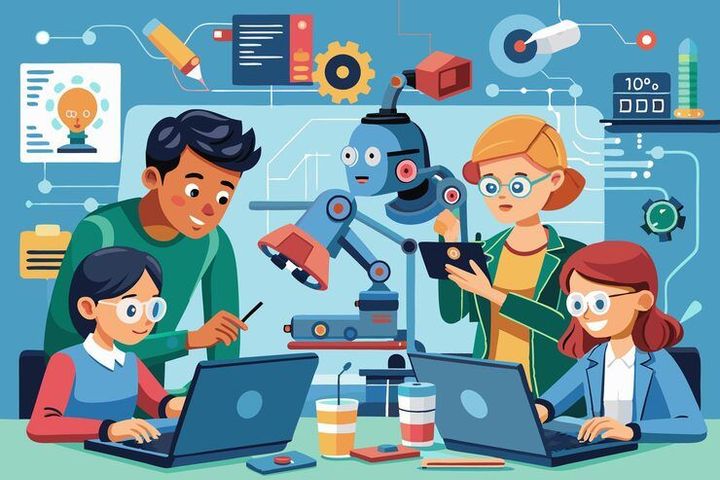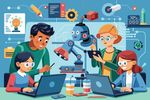
Discover the Future of Robotics Expert Tips, Advice, and Educational Resources
Robotics is the interdisciplinary field combining mechanical design, electronics, computer science, sensor systems, artificial intelligence (AI), and control systems to build machines (robots) that can perform tasks autonomously or semi-autonomously. It exists because of the human desire to automate repetitive or dangerous tasks, extend human capabilities in areas such as surgery, space exploration, and manufacturing, and develop machines that can interact with the physical world effectively. Over time, what began as rigid factory automation has evolved into intelligent, mobile, and adaptive systems that collaborate with humans and respond to complex real-world environments.
Importance
Robotics matters more than ever today due to its growing impact across industries and society.
-
Industrial Impact: Sectors like manufacturing, logistics, healthcare, and agriculture rely heavily on robots for precision, efficiency, and safety. Robots perform tasks in extreme environments, handle repetitive work, and improve consistency.
-
Human Advancement: Robotics helps address workforce shortages, supports elderly care, and enhances capabilities in fields like surgery and environmental monitoring.
-
Economic Development: Automation and robotics contribute to national productivity, innovation, and sustainable industrial growth.
-
Education and Skills: Robotics education prepares the next generation to work with emerging technologies, integrating programming, electronics, and design thinking into school and university curriculums.
-
Global Problem-Solving: From disaster recovery to precision farming, robots provide practical solutions to challenges that are too dangerous, complex, or time-consuming for humans.

Recent Updates
The past year has seen several significant developments in robotics:
-
AI Integration: Modern robots are being enhanced with generative AI and large language models, enabling natural communication and more intuitive control.
-
Collaborative Robots (Cobots): Cobots designed to safely work alongside humans are increasingly common, especially in manufacturing and logistics.
-
Autonomous Mobility: Robots with advanced navigation and mapping capabilities are being deployed in hospitals, warehouses, and public spaces.
-
Digital Twins and Simulation: Virtual models of robots are now used to test designs, monitor performance, and optimize real-world operations.
-
Educational Robotics Growth: Schools and universities are expanding robotics programs, with increased access to AI-based learning kits and coding platforms.
-
Global Trends 2025: Industry leaders predict that “generalist” robotics systems capable of handling diverse tasks will shape the future, powered by breakthroughs in AI, sensors, and energy-efficient hardware.
| Trend | Description | Significance |
|---|---|---|
| AI-Driven Robots | Robots that understand natural language and adapt to environments | Enables smarter, flexible automation |
| Cobots & AMRs | Collaborative and autonomous robots | Improve efficiency and workplace safety |
| Digital Twins | Virtual simulation of robotic systems | Reduces errors and accelerates deployment |
| Educational Robotics | Robots in learning environments | Builds essential 21st-century skills |
| Generalist Robotics | Multi-purpose intelligent robots | Expands robotics beyond single-use systems |
Laws or Policies
Governments and regulatory agencies are increasingly shaping how robotics is developed and deployed:
-
Safety and Compliance: New global machinery regulations focus on robot safety, cybersecurity, and human-robot interaction standards.
-
National Strategies: Countries such as India, Japan, and the U.S. have launched robotics and AI strategies to boost innovation and build skilled talent.
-
Ethical Guidelines: Frameworks around transparency, accountability, and human oversight are being introduced to ensure responsible robot behavior.
-
Education Policies: Robotics and AI education are being introduced into school curricula to prepare students for future industries.
-
Data and Privacy Laws: With robots collecting and processing large amounts of sensory data, privacy compliance and secure data handling are becoming crucial.
Tools and Resources
Whether you are a student, researcher, or enthusiast, numerous resources can help you explore robotics:
Learning Platforms
-
Online courses and certifications focused on robotics fundamentals, AI, and embedded systems.
-
Interactive platforms that teach robotics through simulation and programming environments.
Software and Frameworks
-
Robot Operating System (ROS): The most widely used open-source platform for building and simulating robots.
-
Gazebo and Webots: Tools for designing and testing robots in virtual environments.
-
TensorFlow & PyTorch: Frameworks used for AI integration in robotic vision and decision-making.
Hardware Kits
-
Educational kits that combine sensors, actuators, and microcontrollers to teach core robotics principles.
-
Modular robot kits for schools and labs that encourage hands-on experimentation.
Research & Data Resources
-
International organizations offering reports, whitepapers, and statistics on robotics growth and applications.
-
Robotics competitions and communities that foster innovation and collaboration.
Practical Tips
-
Start with basic programming (Python or C++) and mechanical design.
-
Learn about sensors, actuators, and control systems through small projects.
-
Use simulation before physical deployment to save time and resources.
-
Follow recent research publications and technology news to stay current.
-
Join online forums or local robotics clubs to share knowledge and collaborate.
FAQs
Q: What types of robots are used today?
A: Robots can be industrial (assembly, welding), service-oriented (delivery, cleaning), medical (surgical, assistive), agricultural (crop monitoring), or educational. Each type uses a mix of AI, sensing, and control technologies to perform specific tasks.
Q: Is robotics difficult to learn?
A: Robotics combines several disciplines programming, electronics, and mechanics but modern learning platforms and kits make it accessible to beginners. Consistent practice and curiosity are key.
Q: How is robotics different from AI?
A: AI focuses on cognition perception, decision-making, and learning while robotics combines AI with physical systems to act in the real world. Together, they form intelligent, adaptive machines.
Q: What are the main challenges in robotics?
A: Key challenges include ensuring safe human-robot collaboration, developing autonomy in unpredictable environments, managing energy use, and aligning innovation with regulations and ethics.
Q: What is the future outlook for robotics?
A: Robotics is moving toward greater autonomy, versatility, and collaboration. Future robots will be integrated across all sectors from healthcare to education enhancing human productivity and creativity.
Conclusion
The future of robotics is a blend of innovation, intelligence, and human collaboration. As robots become smarter, safer, and more accessible, they will transform industries, education, and everyday life. Understanding robotics today means preparing for a future where technology complements human potential empowering creativity, problem-solving, and sustainable progress.






